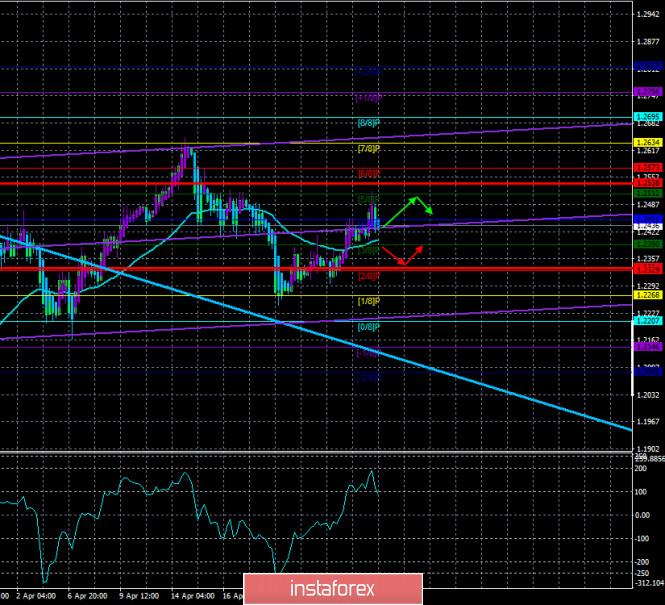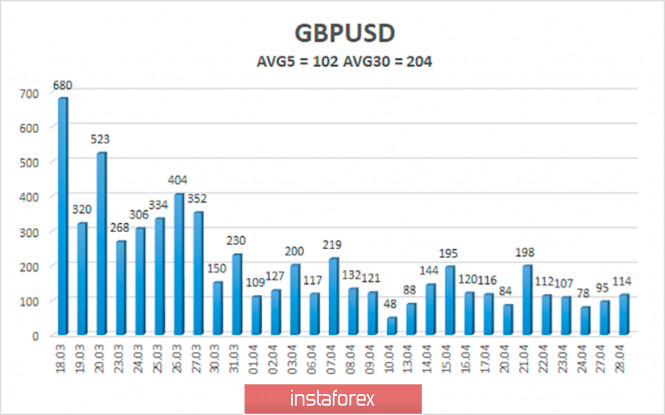4-hour timeframe

Technical details:
Higher linear regression channel: direction - downward.
Lower linear regression channel: direction - upward.
Moving average (20; smoothed) - upward.
CCI: 97.6997
On April 29, the British pound begins a downward correction against the new upward trend that was formed just yesterday. The pound/dollar pair is fixed above the moving average but does not yet give the impression of being ready to form a new upward trend. In principle, there are no particularly good reasons for the growth of the British currency. The UK economy will suffer not only from the "coronavirus" epidemic and the quarantine associated with it, but also from Brexit, negotiations on which can once again be considered deadlocked. So far, Boris Johnson is leading the country to its worst economic decline in decades. The American economy may also suffer serious losses, but they are unlikely to be comparable to the British.
On Wednesday, the pound/dollar pair will be influenced by the same macroeconomic events like the euro/dollar pair. In the UK, no significant publications are scheduled for this day, which means that market participants will focus their attention on the same US GDP report, as well as on the evening summary of the meeting of the monetary committee of the Federal Reserve. According to the tasks set by the US Congress, the Fed should promote employment growth and price stability (this means stable price growth for the same 2% target that was relevant before the "coronavirus crisis"). In the last months before the epidemic, the Fed managed to bring us inflation to a more or less stable 2%+. However, in these conditions, firstly, the significance of inflation itself has become much lower, and secondly, the US government and the Fed have to deal with the fall of the country's economy, so there is simply no need to talk about any stable growth in prices and, consequently, the growth of the economy now. The next meeting of the Fed began yesterday, and its results will be summed up this evening. In fact, no changes in monetary policy are expected. Jerome Powell and company have already lowered the key rate to almost zero, leaving themselves a minimum of room for maneuver in the future. The quantitative easing program has been expanded to uncertain values, and the Fed's balance sheet has already ballooned to 6.2 trillion, in addition to this, both the Fed and the US Congress have financed the country's economy by several trillion dollars. Moreover, it is now quite difficult to understand what specific losses the American economy will suffer? We can only judge unemployment with a high degree of probability by analyzing reports on applications for benefits. Today, the change in GDP will also be known, and the Fed itself will publish its forecasts for key indicators of the economy in the evening. However, the crisis is also a crisis that it is very difficult to control and predict. Moreover, the crisis is not yet complete, it has not even entered the stage of slowing down the fall. Donald Trump and Steven Mnuchin have already said that the economy will slowly restart, and the economic borders of the states and the country will open. However, no one knows how it will end. It is possible that there will be a second wave of the epidemic. For example, the head of the Federal Reserve Bank of Atlanta, Raphael Bostic, believes that we need to look at public health, not the economy. "While the virus continues to spread, we need to maintain some restrictions in the economy," Bostic said. Thus, at the end of the meeting, the markets want to get information about how long the Fed plans to keep rates at ultra-low levels, as well as how the FOMC assesses the prospects for the economy. For example, after the 2008 crisis, the American economy began to recover only in 2009, and the labor market began to show steady growth only in 2010. World experts are increasingly comparing the current crisis (which is not yet over!!!) to the Great Depression, which lasted at least 4 years. The same experts believe that the "mortgage crisis", during which the world economy showed growth of 0.18%, is in no way comparable to the crisis caused by the COVID-2019 pandemic. Thus, it is logical to assume that the decline will be more serious than 12 years ago. Market participants are also waiting for information from the Fed about the future direction of the economy. After all, the rhetoric of the Fed will depend on the desire of businesses to resort to borrowed funds. Even if borrowing is very cheap, as it is now, this does not mean that all companies will resort to using this tool. Companies should be optimistic about the future and understand the precise time frame when the crisis will end and the economy will start to recover. This will determine the mood of investors, managers, and their desire to take out loans and revive their own business.
Well, in the UK at this time, Boris Johnson, who only returned to the role of Prime Minister on Monday, came under harsh criticism. As we have previously written, the claims against Johnson are reduced to underestimating the high risk of an epidemic in the country. The warnings of authorized persons about the threat of an epidemic were not taken into account, the health sector was not prepared for a possible pandemic, as a result, the country faced a high number of diseases and a high death rate, much higher than the 3-5% that is "average" for the virus. The country has already registered 158,000 cases of the disease. Thus, Britain has almost caught up with Germany, which also has 158,000 cases of infection. However, if Germany recorded 6,0000 deaths from the disease, in Britain – 21,000, that is 3.5 times more. Moreover, yesterday, doctors in the UK made an official statement, according to which a new dangerous viral disease in children was detected, which may be associated with a "coronavirus". British Health Minister Matt Hancock yesterday made a statement about a new disease that is still unknown to doctors. It is reported that the new disease affects mainly children who are hospitalized with heart and abdominal pain. "There is growing concern that British children are developing an inflammatory syndrome associated with Sars-CoV-2, or that another, as yet unidentified, the infectious pathogen may be present in these cases," say representatives of the UK's national health system. Over the past three weeks, the number of children with an unknown disease similar to Kawasaki syndrome, for which there is no treatment, has increased significantly. However, many children did not show signs of "coronavirus". Thus, at the moment, it is not even clear whether the new pathogen is related to COVID-2019 and where it came from.

The average volatility of the GBP/USD pair has stopped decreasing and is currently 102 points. In the last 20-25 trading days, the volatility indicators have been stable. On Wednesday, April 29, we expect movement within the channel, limited by the levels of 1.2334 and 1.2538. Turning the Heiken Ashi indicator down will indicate a downward correction or even a possible resumption of downward movement.
Nearest support levels:
S1 - 1.2390
S2 - 1.2329
S3 - 1.2268
Nearest resistance levels:
R1 - 1.2451
R2 - 1.2512
R3 - 1.2573
Trading recommendations:
The GBP/USD pair may start to adjust on the 4-hour timeframe. Thus, traders are recommended today to consider buying the pound with the goals of 1.2512 and 1.2538, after the reversal of the Heiken Ashi indicator back up. It is recommended to sell British currency no earlier than fixing traders below the moving average line with the first goal Murray level of "4/8"-1.2329. Toward evening, you should be as careful as possible with any positions, since bursts of emotions in the foreign exchange market are possible.
The material has been provided by InstaForex Company - www.instaforex.com